A Walk in the Gardens...
- Merri-Lee M.
- Oct 9, 2022
- 9 min read
Updated: Jan 4, 2023
Every year, we look forward to the profusion of colour brought to our gardens by flowering plants. If the blossoms on our plants are nectar-rich, they will almost certainly attract some wonderful pollinators.

If we also choose to include some native host plants, with specific species of insects in mind, we may be lucky enough to see entire life cycles in our gardens.
(Monarch Caterpillar in Swamp Milkweed)

If I had my preferences, I would always take photos in soft, early morning or evening light. Insects gathering pollen and sipping nectar have different preferences! The busiest time of day for pollinators is often right around noon in the harsh light of midday. So... enjoy the brilliant colours and bold beauty of Summer!
One of the earliest flying guests in gardens is the Common Eastern Bumblebee, and it was great to see a fairly good number of them during the course of the season.
They were regular visitors to the first flowers of Spring; later in the Summer, they enjoyed Cosmos, Bee Balm, and Coreopsis. This busy little Bumblebee has collected a load of pollen on its legs.

There was lots of flower-space to share with a wee Leaf Beetle.
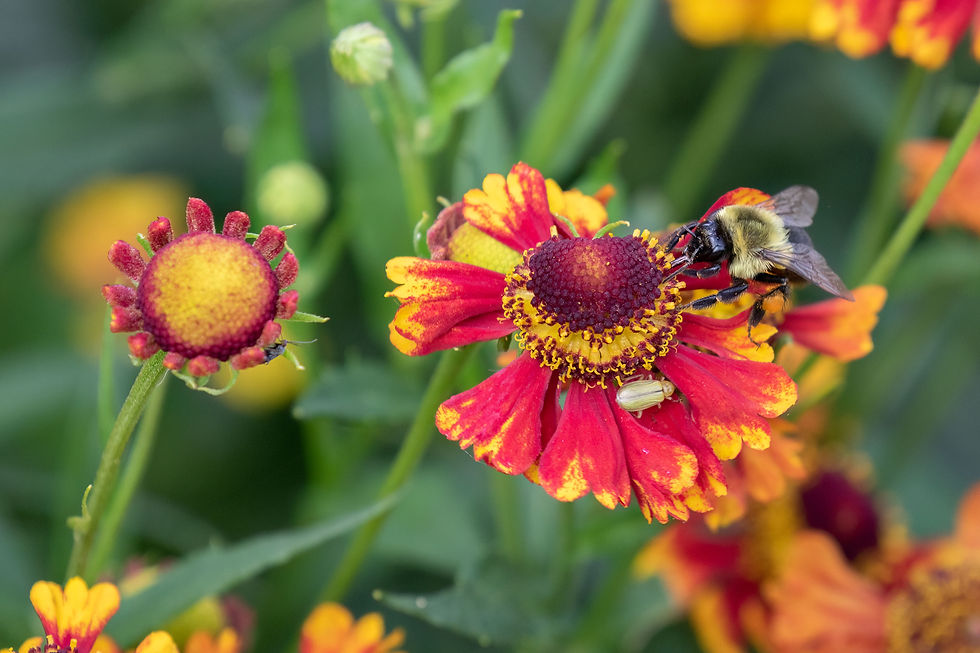


Other flies, bees and wasps were plentiful in the blossoms; this fly is possibly an "Australian Sheep Blow Fly". Cool-looking bug with a not-so-nice name!

Common Drone Flies and beetles loved New England Aster.

European Drone Fly was another interesting visitor.

There were plenty of Great Black Digger Wasps in the Swamp Milkweed this year, with their iridescent blue wings.

Honeybees were not seen in the same numbers as other years; however, there did seem to be more of them as the Summer progressed.


Along with other insects, there have been some wonderful butterflies in the gardens and along the roadsides this Summer -- again, perhaps not as many as other years, but a good variety. It's always nice to see them when they first emerge, bright and fresh, wings intact and strong.
This stunner is a brand new Red Admiral, found along the edge of MacGregor Point Provincial Park, in a natural roadside "garden", sipping nectar from one of the many Knapweed flowers. While not a native plant, Knapweed does seem to be a favourite for nectaring butterflies.
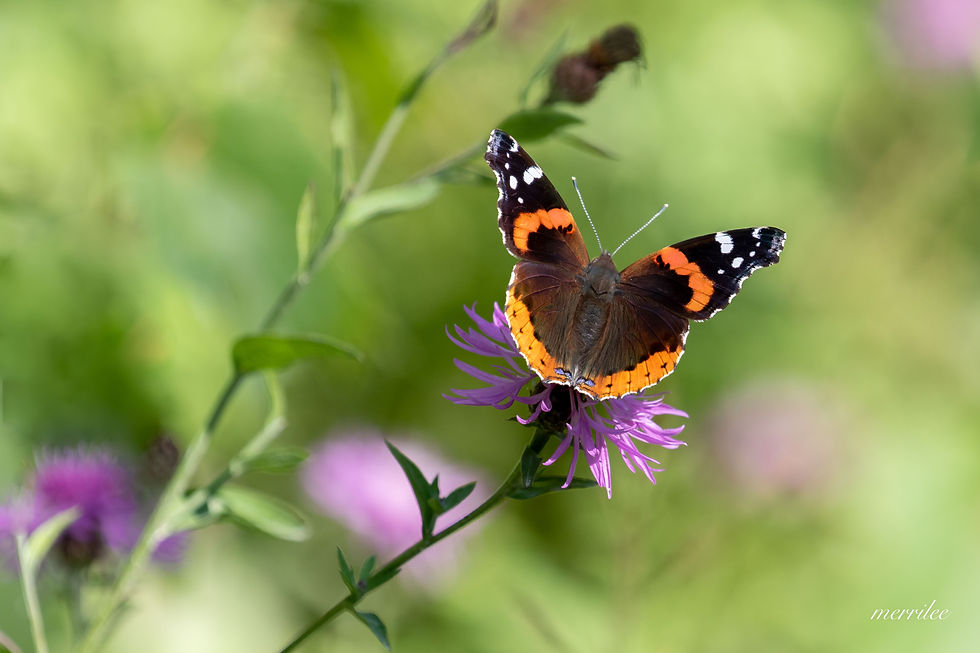
Gorgeous inside and out! And I love their faces.
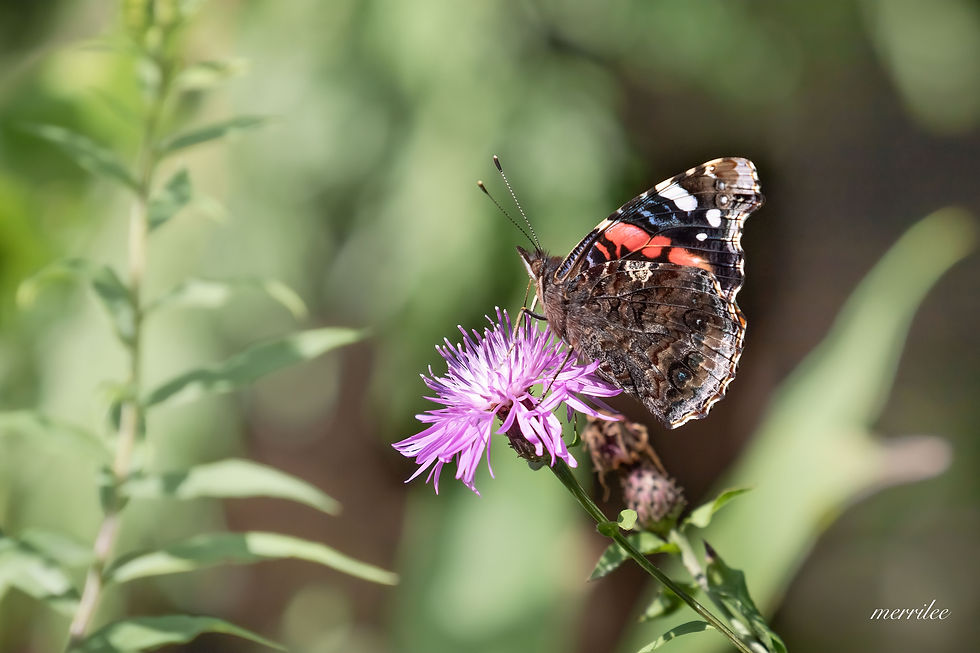
Great Spangled Fritillaries around MacGregor also favoured Knapweed as a nectar source,

sometimes even doubling up on one flower. Must have been an extra tasty one!

This Fritillary sipped from Flat-topped Goldenrod.

I love the patterns on the wings of the Great Spangled Fritillary. Here is a closer look at the "spangles":

Early in the season, I saw an American Lady Butterfly (with bites missing from its wings) on a Garlic Mustard plant. Guess this invasive plant is good for something??

In August, the second generation of American Ladies must have been busy laying eggs. A favoured host plant for their larvae is Pearly Everlasting, and the little guys, in all their various stages, completely demolished my entire patch!



Fortunately, a generous friend** allowed me to raid her garden for some stems of Pearly Everlasting, and the caterpillars were able to feast their way to the chrysalis stage! Interestingly, some of them found a nearby Globe Thistle, and were willing to chew on the leaves of those plants too.
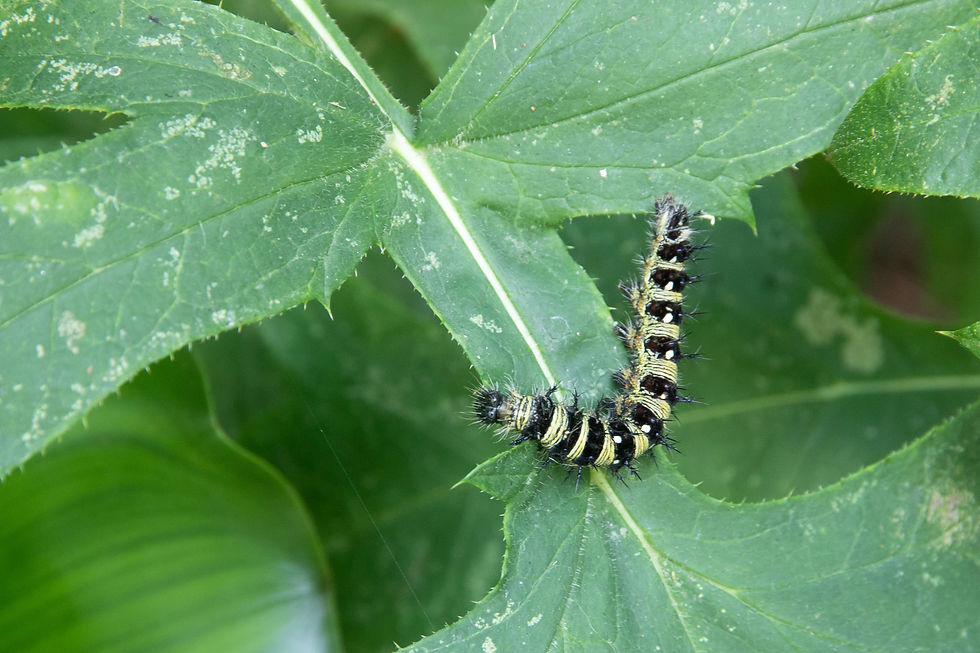

Strands of webbing surround this chrysalis, and the shed skin is below...

Within a few weeks, lovely "Ladies" were emerging and keeping me company in the gardens. And the Pearly Everlasting didn't take long to start producing new shoots. Interestingly, American Ladies were among the few butterflies that even bothered to try to find nectar in the Rudbeckia,

and in these flowers -- Variegated Coreopsis, I think.

Some Butterflies look a bit drab with their wings closed. Not the American Lady! This particular butterfly checked out all sorts of plants -- here it is perched on Sedum.

It sipped from the Rudbeckia flower with Black Anise Hyssop in the background,

and on the Obedient Plant;

on the Heliotrope,

and on the Salvia. American Ladies, unlike other butterflies in the gardens, seemed willing to take nectar from any number of flowers.

And here is the American Lady Butterfly sharing flowers with a Small Milkweed Bug, while a Monarch Caterpillar looks on from its perch on a Swamp Milkweed leaf. Busy spot, and lots of food and real estate for everyone!

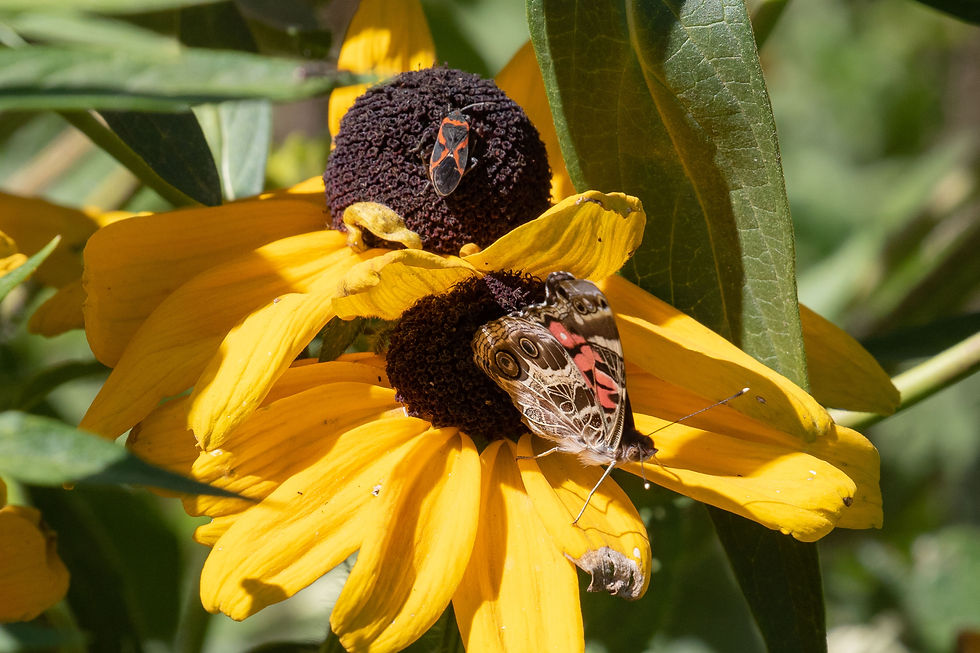
A butterfly that I usually see in good numbers during the Summer months is the Eastern Comma. I didn't see many at all this year...


In early Summer, one of our Pussy Willow Trees looked a bit sparse... more than 40 Mourning Cloak larvae were munching away on the leaves! I brought a few into the Butterfly Box, and they emerged into lovely butterflies.

In early September, there were Mourning Cloaks flying and nectaring again. They and all of their friends loved the brilliant blooms of Butterfly Bushes.

A Viceroy Butterfly looks very much like a Monarch, but is smaller, and has distinctive markings on the wings.

This is a newly-emerged (female) Monarch -- note the differences in the patterning, especially on the hindwings of the Viceroy and the Monarch.

Unlike Monarchs, Viceroys do not depend on Milkweed; however this one sat for several minutes on Common Milkweed as it dried its wings.

Another Viceroy was resting on a Swamp Milkweed plant, while a Monarch Caterpillar fed on a leaf in the background.

Viceroy on Queen Anne's Lace

Early in the Summer, a Viceroy Butterfly laid eggs in our Curly Willow Tree. Maybe next year there will be more of these infrequent guests.
At various times during the Summer, there were Red-spotted Purples in the garden. The Mint patch was a great place to rest and feed for a variety of pollinators.

And, as the Mourning Cloaks already told us, Butterfly Bushes are always a favourite sipping spot! It wasn't unusual to watch a butterfly land on one stem, and make its way all around the cluster, dipping its "straw" (proboscis) into each little floret.

Purple Coneflower is delicious too ... sometimes you have to sneak up on it.

It isn't often that a butterfly perches in just the right spot, but this Red-spotted Purple was pretty accommodating for a few moments.

This beauty is, I believe, a hybrid of a White Admiral and Red-spotted Purple. Or could it just be an extra colourful White Admiral???


There were 3 kinds of Swallowtails around the farm this year. The first one I saw was a somewhat battered Canadian Tiger Swallowtail resting on the Mint.

If you look closely, you can see pollen scattered along the Swallowtail's wing and head.

There were also Black Swallowtails in the yard and gardens, and they laid eggs in the Parsley, Rue and Dill. The Caterpillars shed their skins several times, changing their "looks" completely.


Once they had fattened themselves sufficiently on my herbs, they spent a few weeks in chrysalis, then emerged as beautiful Black Swallowtail Butterflies. This one is a rather faded male, with the large yellowish spots, and only a small amount of blue near the bottoms of the hindwings. It looked as though a hungry bird had tried to catch him, but he seemed able to fly without difficulty in spite of the wing damage.

I love the fine, delicate legs and antennae of butterflies, and the slim proboscis dipping into flowers (Zinnias).

This Black Swallowtail is a female, with the iridescent blue patches on the hindwings.
Another Knapweed fan!

The third Swallowtail that frequents our farm is the Giant Swallowtail. Females lay eggs on the tops of Gas Plant leaves, on Hop Trees, and on Prickly Ash. These plants have been hosts to our largest butterflies for about 5 years now in our gardens. Tiny caterpillars crawl out of the eggs...

and morph into the strangest looking "bird-droppings"

that "stick out their tongues" when disturbed. (The organ is actually called an "osmeterium", and emits an odour that is repulsive to predators!)

Hard to believe these guys turn into Giant Swallowtail Butterflies...

The second generation of Giant Swallowtails overwinters in chrysalis form, and emerges in the Spring. Our largest butterfly, and such a beauty!

I found some interesting "tiny" butterflies this Summer too... the first ones were all seen in and around MacGregor Point Provincial Park.
An Acadian Hairstreak stopped for a moment near a pond, and peeked out from behind its hiding spot.

One Northern Pearly-eye deposited eggs on a blade of grass,

while another, brighter Pearly-eye rested on a leaf. Flitting through the forest, these little creatures appear to be rather drab and brown, but ... look at the details!

A Wood Satyr posed briefly on a leaf,

and a Northern Crescent balanced on the tip of a flower.


We saw Small Heath Butterflies in many different locations this year.

I rarely see Bronze Copper Butterflies, and am always thrilled when one appears! It's especially nice if they land nearby, in nice light! When one is perched on a piece of grass, or on a tiny Fleabane(?) flower, we can see how small they actually are.


Not a Butterfly, but an interesting Moth: Silver-spotted Skipper.

Around home, there were some small butterflies that were new to me. How pretty is this Eastern Tailed-Blue? Check out the teeny tails!


There was a very short visit by a Striped Hairstreak.

And I did not know that a Summer Azure would lay eggs on Swamp Milkweed. Look closely at the second photo, and you can see a minuscule white egg.
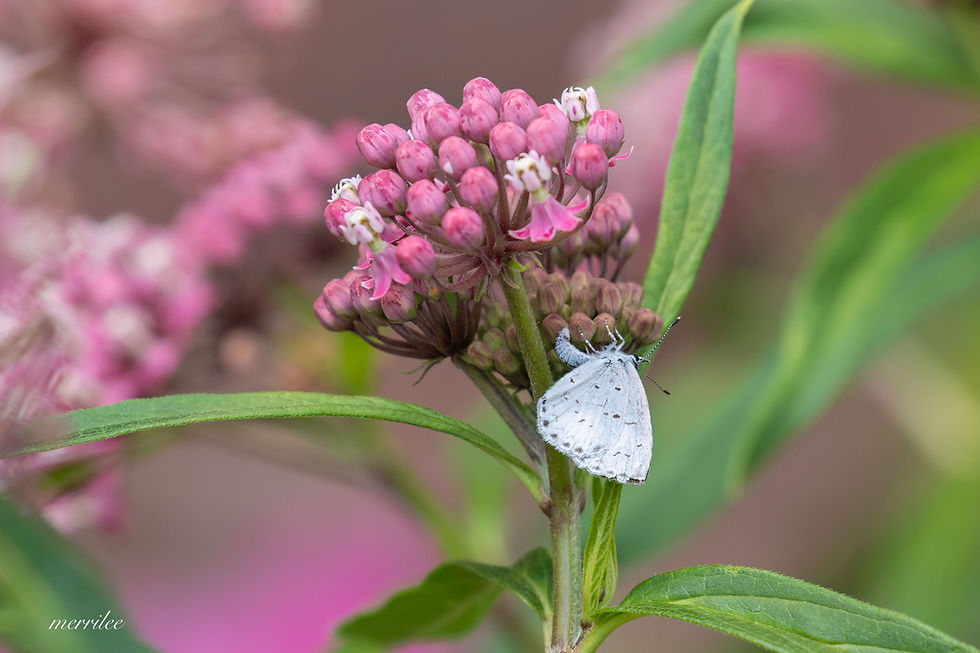

It's a real treat to see a Hummingbird Clearwing Moth, even for a few brief seconds! There is usually one at some point every Summer in the Phlox, but they never stay for more than a day.

Late in the season (October 4), this pretty creature showed up in the flowers, newly emerged and hungry! It was the first Milbert's Tortoiseshell that I have seen this year, but there were likely others laying eggs earlier, if new ones were appearing in October.
I think the undersides of the wings are lovely, with their brown patterning,

but when a brand new Milbert's Tortoiseshell opens its wings, .... wow! Perched on a small Bidens flower, sipping and resting for a few moments, this is indeed one of the most striking of our Summer butterflies.

Earlier in the Summer, a Compton Tortoiseshell stopped by very briefly for a sip of orange juice, but didn't open its wings for me!

Dragonflies and Damselflies were plentiful this dry, hot Summer, and were every bit as impressive as their butterfly friends; I have included a few of these lace-winged lovelies with this collection of Summer insects.
I believe this is a Shadow Darner, resting in my Joe-Pye Weed.

A Darner (not sure which one?) flew in the car window and landed on the driver's hand. Perhaps it was trying to escape from a hungry bird. (MacGregor)
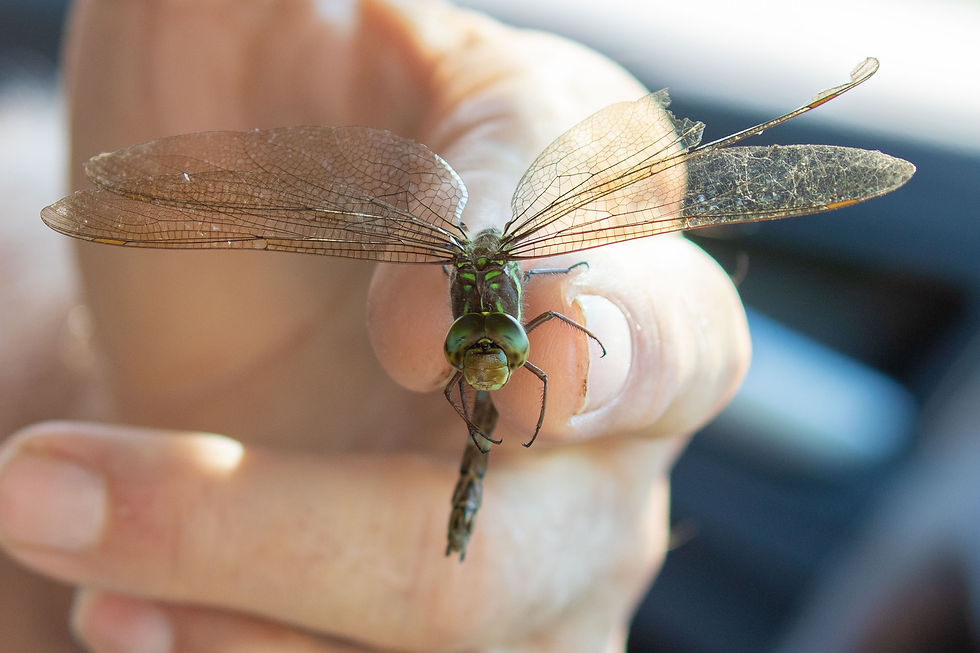
A Canada Darner, I think ... such a striking creature, with the intricate blue/green/brown patterns (which would be easier to see if the Darner had perched somewhere else!). (MacGregor)

Tiny Autumn Meadowhawks enjoyed some early September warmth along a trail in MacGregor.

The Familiar Bluet is a common, petite Damselfly. I believe this one is a male; the female would be brown.

In the late afternoon sunshine, a Widow Skimmer (Dragonfly) rested.

Last Fall, someone gave me a chrysalis that they had found, and it overwintered in the Butterfly Box. One Spring morning, out came a stunning Polyphemus Moth.


Not hard to see what this Moth's defense strategy is! Interesting (and kind of disappointing!) to note that Polyphemus Moths do not eat, and only survive for about a week after emerging from the chrysalis.

And finally, here is the dazzling, shimmery Ruby-throated Hummingbird that perched quietly on some spent Swamp Milkweed, oblivious to me as I stood watching a Monarch a few feet away. She (I believe this is an adult female) and her family and friends had been busy for days, filling their bellies with nectar from the flowers in our gardens, in preparation for their long flights South. There is pollen on her bill from her recent tour of a Rose of Sharon plant.
Hummingbirds are know for their "feistiness", their tenacity, their almost frantic energy... it was a privilege to share a rare peaceful moment with this tiny friend.

As I finish up this blog entry, it is dark and cold outside, and there is a sense of sadness in the knowledge that bright blossoms and flying creatures of Summer have abandoned us for a few seasons! There are still late Monarch caterpillars and chrysalises around the house; I have brought some inside, out of the almost-freezing temperatures. (We may have to charter a flight to Mexico for them in a few weeks ... any willing pilots out there??)
Here, a Monarch and 2 Honeybees share the flowers of native New England Aster.

It has been extremely gratifying to have observed the many species that have "graced us with their presence", as native and nectar plants have been preserved or added to our landscape. Walking on trails and sideroads that have been allowed to remain in their natural state has yielded many wonderful encounters as well. Diversity, interdependence, interconnectedness -- all are on full display in the increasingly uncommon places in which Nature is allowed to fulfill her ancient agenda.
"In the Western tradition there is a recognized hierarchy of beings, with, of course, the human being on top -- the pinnacle of evolution, the darling of Creation -- and the plants at the bottom. But in Native ways of knowing, human people are often referred to as "the younger brothers of Creation." We say that humans have the least experience with how to live and thus the most to learn -- we must look to our teachers among the other species for guidance. Their wisdom is apparent in the way that they live. They teach us by example. They've been on the earth far longer than we have been, and have had time to figure things out." --Robin Wall Kimmerer
A Rare Natural Roadside "Garden" on the Edge of MacGregor Provincial Park

Fall Blessings to all of you!
-Merri-Lee
*In this blog, I have tried to identify both "host" and "guest" (usually plant and insect) in each photo. All of these treasures were found around our home, or around/in MacGregor Point Provincial Park. Because of the number of photos that I had to work with(!), I have chosen not to present a great deal of information beyond ID. As always, your comments and corrections are welcome. I am learning by trial and error, and rely heavily on my books, Seek app, knowledgeable friends, and Google!
** And many thanks to Thelma Beaubien for sharing some of her Pearly Everlasting stems with my hungry American Lady caterpillars!




Breathtaking as always!
Beautiful little visitors. It is sad to see the flowers and these lovely guests disappear. We look forward to their return. Thank you for sharing your amazing photos.